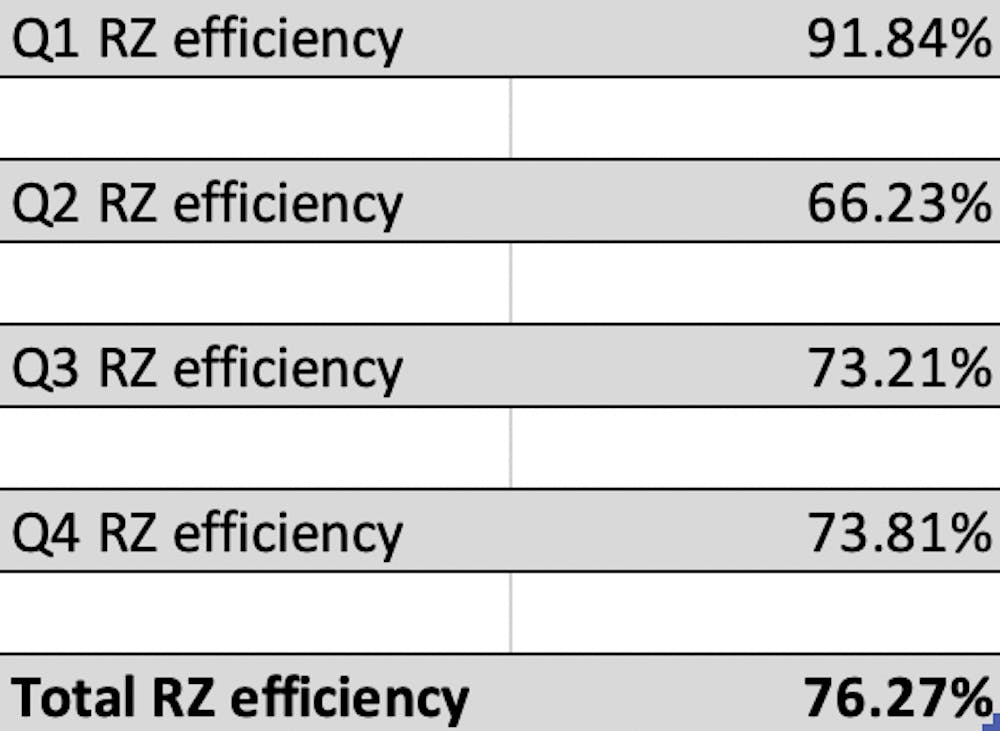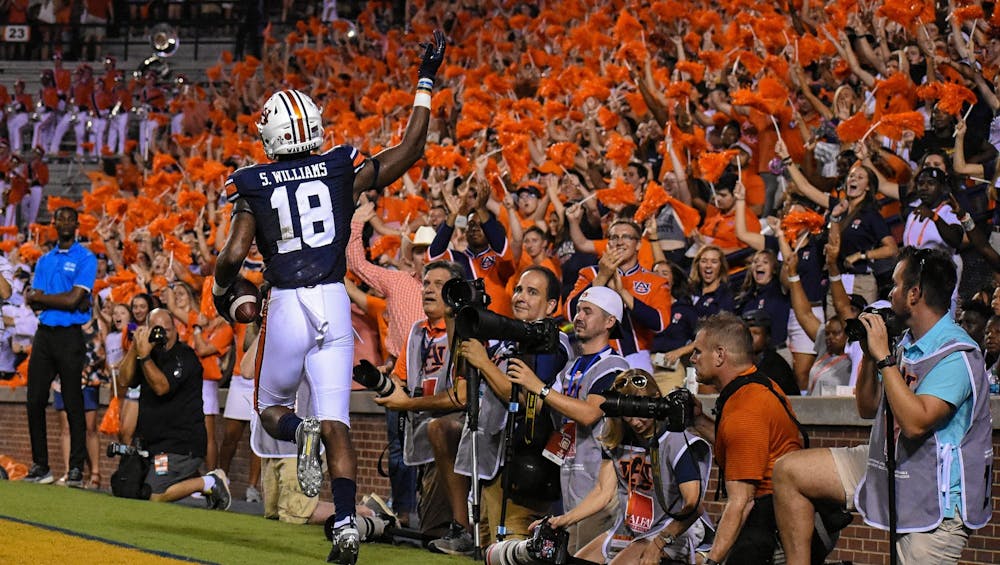Through nine weeks of play, the No. 12 Auburn Tigers have totaled 8,326 yards of offense and 37 offensive touchdowns in their seven wins and two hard-fought road losses.
Of their remaining three games, two are considered to be among the most anticipated matchups of the year: No. 4 Georgia and No. 5 Alabama. The outcomes of these two games could affect not only the lineup for the SEC Championship game in December, but also the entire College Football Playoff in January.
The bye week before facing the Bulldogs on Saturday serves as the perfect time for the Tigers offense to take a look at their strengths and weaknesses from the past nine games in order to tighten up in certain areas.
Statistically, it’s easy to see what those areas are, and in order to stand a chance during 2019’s installment of Amen Corner, Auburn’s offense will have to work on most of, if not all of these things in a big way.
Red-zone offense
The Tigers have reached their opponents’ red zone exactly 38 times this season. On those red zone attempts, they have scored 33 times for 198 points.
This is a significant amount on paper, averaging 22 red zone points per game, however the distribution is very lopsided. Forty-one of those points came on seven scores against Kent State, 35 more on five scores against Mississippi State, and 27 on four scores against Arkansas, all of which were in Auburn’s three highest-scoring games this season.
From there, the numbers are far more sparse. Auburn’s offense scored no more than 21 points against any other opponent when in the red zone. Auburn also failed to reach Florida’s red zone more than once and failed to put any points on the board on that one attempt. Using a metric that calculates red zone efficiency by factoring in how many points were actually scored over how many points could have been scored, Auburn’s total red zone efficiency is 76.27%, however, a quarterly analysis of this total shows that red zone efficiency drops to just 66.23% in the second quarter.

On average the second quarter tends to be Auburn’s worst offensively, and the point totals show it. Auburn’s offense has managed only nine touchdowns in the second quarter through all nine games, with six of those happening in matchups against Tulane, Kent State and Mississippi State.
Against Top-25 opponents, of which Georgia and Alabama are in the upper echelon, Auburn has scored 10 touchdowns. Only three of them were scored in the losing efforts against Florida and LSU. Alabama’s defense will not be forgiving in the red zone, and Georgia’s even less so.
Offensive line cohesion
If the ball is to be run up the middle, as it often times is, the O-line’s job is to create a hole for the running back to carry through. If the ball is to be thrown, the O-line is supposed to hold off the onslaught of the opposing defensive line and give the quarterback the necessary time to complete his throw.
In every game but the Tulane game, Auburn’s O-line has allowed a sack by the opposing team. The most sacks happen in the second quarter with seven second quarter sacks, or 0.78 sacks per game.
A trend becomes quite noticeable in the second quarter, which is the only quarter in which Auburn’s offense averages more passing yards than rushing yards. In the first quarter, the Tigers average 62 rushing yards per game. Just one quarter later, they average a mere 38.78 yards.
The inability of the offensive line to open holes for the running backs causes the quarterback to throw the ball more frequently, boosting average passing yardage from 50 yards in the first quarter to 59 yards in the second.
This also partly accounts for the low scoring totals in the second quarter across the board. As the QB begins to throw the ball more quickly and more frequently, completion percentage falls drastically from 59.82% to 38.27%.
This leads to more three-and-outs, which allows for more playing time for the opposing offense. Against high-powered defenses like Georgia and Alabama, the offensive line will be crucial in the effort to score.
Without significant improvement in total offensive line cohesion, the defense will not only sack the quarterback for significant yardage losses, but also stymie the Tigers’ running game, forcing them to become more one-dimensional with an emphasis on passing. With a quarterback whose total completion percentage against Top 25 opponents is 45.1%, that situation is one best avoided.
First-half play
Auburn fans have long loved the idea of Auburn being a “second-half team,” putting forth enough effort in the first half to stay competitive while saving enough energy to explode out of the gate and play relentlessly in the second half.
As mentioned earlier, in the second quarter Auburn is averaging only 38.78 yards per game. Auburn has scored 150 points in the first half of nine games. The Bulldogs have only scored 153 first half points this season, and the Crimson Tide has scored 244.
Auburn’s offense must do the same to stay competitive. Should Auburn fall too far behind in the first half, will its offense be able to make the comeback? Statistically, the answer is no. Auburn has completed one successful second-half comeback this year in the season opener against Oregon. In every other game this season where the Tigers were down or tied at the half, they end up losing.
Third-down offense
The total conversion percentage for Auburn’s offense on third down is 44.53%, ranking them 26th nationally. When looking at specifically third-down conversion against Top 25 teams, that falls to 28.75%. In some instances, it is better to be conservative and attempt to simply advance the ball, such as in Baton Rouge when Auburn faced third-and-27 after a botched snap two plays earlier carried the ball 20 yards behind the line of scrimmage.
However, what also must be taken into account is the fact that the offense will only have the ball so many times during the game. Auburn averages 14 possessions a game. Auburn’s offense averages more rushing yards per quarter and much better completion percentages per quarter in the second half, and it converts 45.67% of its third downs.
The Tigers have to get at least within field goal range on every possible drive to have a chance at winning against our remaining opponents. For example, Auburn punted nine times against LSU. A field goal on even one of those drives means a tie game and likely overtime.
Overall consistency
Offensive consistency is crucial for a team looking to upset CFP hopefuls. Note, though, that consistency is not the same as repetition. Consistency is finding a way to move the ball for meaningful yardage on every play. Where are more plays like Anthony Schwartz’s first touchdown run against Texas A&M? When will we again see the likes of Harold Joiner’s reception and explosive run for 78 yards? Or how about DJ Williams bulldozing down the field for 41 yards, only to later run again for 70 more?
If the Tigers truly desire to run the ball, they’ve proven in the past they can get it done on the ground — and get the ball to their top playmakers. Strides were made with this against Ole Miss, when Schwartz caught a career-high nine balls.
The Tigers must also execute plays more than they have been. They have to find rhythm and sustain it. When they average three quarters of 60-plus rushing yards, 50-plus passing yards and 50% or higher completion percentage, a four-quarter effort in all those categories could mean double-digit wins by season’s end.
----------
Full quarter-by-quarter breakdown of Auburn's offensive production here.
----------
Head coach Gus Malzahn gave perhaps the best answer after the win against Ole Miss, a game in which 507 total yards of offense translated to only 20 points.
“Well we won. I think that’s kind of how you assess it,” he said. “We won the game, proud of the fact we won the game, but you know, we gotta clean some things up, but the fact that you put up 500 yards against a good defense, especially a good run defense, you know, that’s good. So we just gotta finish some things and put some points on the board.”
The question on everyone’s mind all season has not been, “Can the Tigers’ offense get the job done?” Fans only need only look back as recently as 2017 to remember that Auburn has been here before, and it came out the victors against both rivals.
They could also look back to 2013 for the November weekends that brought fans the Miracle in Jordan-Hare and the Kick Six.
Or back to 2010 to remember that the Tigers went into Tuscaloosa, trailed by 21 at the half, and stormed back to win the game because they refused to give up.
The key to November wins will be the defense holding UGA and ‘Bama down and the offense taking advantage of all the opportunities it’s given.
But increasing efficiency and production in the aforementioned five categories wouldn’t hurt, either.
Do you like this story? The Plainsman doesn't accept money from tuition or student fees, and we don't charge a subscription fee. But you can donate to support The Plainsman.





